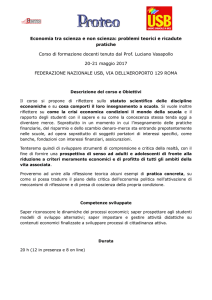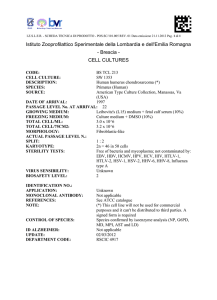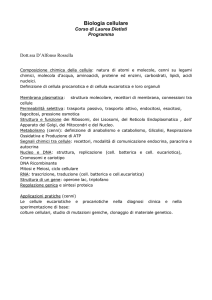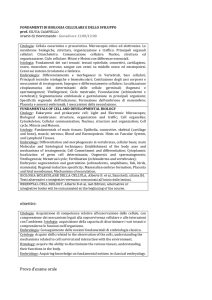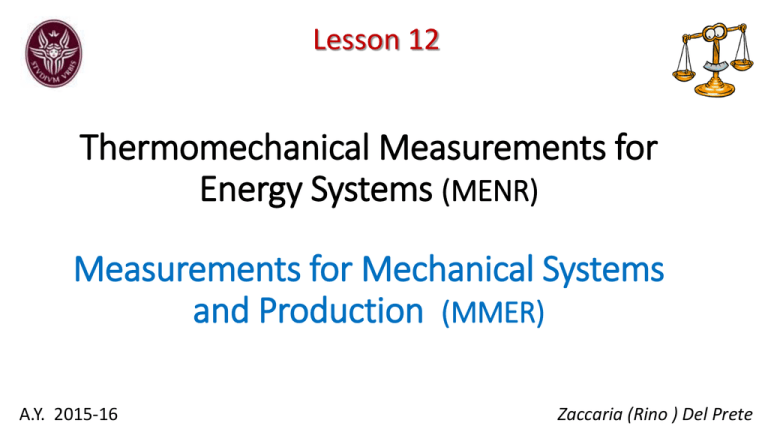
Lesson 12
Thermomechanical Measurements for
Energy Systems (MENR)
Measurements for Mechanical Systems
and Production (MMER)
A.Y. 2015-16
Zaccaria (Rino ) Del Prete
Hydrogen Fuel Cells
Fuel cells are electrochemical devices
capable of converting the chemical
energy of a fuel (usually hydrogen)
directly into electricity without the
intervention of a thermal cycle,
obtaining therefore higher conversion
efficiency compared to conventional
heat engines …
2
A brief history of Fuel Cells
The first fuel cell was built by Sir William Grove in
1839, who used platinum electrodes and sulphuric
acid as electrolyte. Later, starting in 1890, William
White Jacques used phosphoric acid instead of
sulfuric acid. These early devices were however
characterized by a low current density (low
efficiency).
Bacon, after 1930, replaced the first acid
electrolyte of the cells with an alkaline electrolyte
and continued to develop the system (cell of
Bacon) today known by the acronym AFC (Alkaline
Fuel Cells). The AFC were so popular that in the
years' 60 they were chosen by NASA for the
APOLLO lunar mission.
At the end of the years' 50 the use and the development of the PEMFC (Proton Exchange Membrane Fuel
Cells) began; these cells use a special polymer membrane as electrolyte for exchanging protons. The
production grew in the USA and was used by NASA for the space project GEMINI.
3
ELECTROLYSIS of WATER
The water is decomposed into its constituent elements, hydrogen and oxygen (the presence of salt Na2SO4
dissolved in the water serves to increase the conductivity of aqueous solution). At the negative electrode we
have the reduction (cathode) of the water with formation of gaseous H2, while the positive pole we have the
oxidation (anode) with production of O2 gas.
Anode (+) : oxidation
2 H2O →
Cathode (-) : reduction
4 H2O + 4e- → 4 OH- + 2 H2
Total reaction of the process :
2 H2O → O2 (g) + 2 H2(g)
O2 + 4H+ + 4 e-
g = gas
4
CLASSIFICATION and WORKING SCHEME of the FUEL CELLS
AFC
Alkaline Fuel Cell
PEMFC (SPFC)
Proton Exchange Membrane
Fuel Cell
PAFC
Phosphoric Acid Fuel Cell
MCFC
Molten Carbonate Fuel Cell
SOFC
Solid Oxide Fuel Cell
5
PEM: polimeric electrolyte cell
PROS
•
•
•
•
low operating temperature
easy starting (order of minutes)
high yield (power density)
no corrosion problems (typical of other
types of cells with liquid electrolyte)
• Quite simple construction
CONS
anodo :
H 2 2 H 2e
catodo :
1 O 2 H 2e H O
2
2 2
• poor tolerance to the presence of CO in
the fuel
• difficult thermal integration between the
fuel treatment system and the stack
6
As mentioned, there are various types of fuel cells. However, for automotive traction the best candidate appears
to be the Polymer Electrolyte Cell.
In the figure are represented in order:
1.
2.
3.
4.
5.
The bipolar plates which make up the cell's terminals, to them
is connected the external electrical circuit that will use the
current produced by the cell.
The proton exchange membrane which forms the electrolyte
that allows ions to migrate.
The electrodes which represent the active sites where
hydrogen oxidation and oxygen reduction happens; the
membrane and electrode together is typically referred to as
MEA (Membrane Electrode Assembly).
The sealing system which ensures the device sealing of the
reagents and the cooling fluid.
The gas diffusion layers which convey the reagents to the
active sites and are made up of tiny channels distributed close
to the electrode.
7
8
Why don't we allow the reagents to pass
directly through the catalytic layer ?
Why is the electrode substrate necessary ?
The substrate, being of porous material, allows
access of the reagent gases under the structure
of the bipolar plates. At the same time, it
provides a conductive path to the patterned
area of bipolar plates.
Bipolar plates must operate a balance between
gas supply and electrons conduction. The best
conductor, a solid sheet full, would not allow
access to any gas while a completely open
structure would not allow any current to flow.
9
A FEW ELEMENTS OF THE CELL THERMODYNAMICS
The energy available at the equilibrium conditions (constant pressure and temperature) in a cell is given by the
change of free energy:
G nFErev
H 2 2 H 2e
1 O 2 H 2e H O
2
2 2
where:
n
number of electrons participating in the reaction = 2
F
Faraday constant = 96484 C/mol
Erev
reversible cell potential
Nerst's equation determines the thermodynamic potential of the complete redox reaction;
this potential represents the e.m.f. (electromotive force) of the cell in open circuit conditions :
p H2 (pO2 )
ΔG
R T
E
ln
2F
2F
p H2O
0
E
1
2
10
A fuel cell operating in standard conditions, that
uses hydrogen and oxygen electrodes in open
circuit, is capable of supplying a voltage Erev of
1,229 V. When the cell delivers a current to an
utilizer, polarization phenomena arise that cause
localized voltage surges resulting in lowering of
the measurable voltage at the electrodes.
The measurable voltage then has the following expression:
VFC Erev (Vohm Vatt Vcon )
where VFC is the overall voltage measurable at the cell terminals and the three terms Vohm, Vatt, Vcon
summarize the effects of the cell polarization.
11
Cell polarization effects
Activation Polarization (activation loss)
it is correlated with the speed of the reactions at the electrodes. In the case of electrochemical reactions
where Vatt is in the order of 50-100 mV, it can be expressed by the equation of Tafel :
Vatt
RT
i
ln a b log i
nF i0
RT
log i0
nF
RT
b 2.3
nF
where
α = charge transfer coefficient
i0 = exchange current density
a 2.3
Activation polarization is correlated to the slow reaction parts, to this kind of polarization contribute
processes involving adsorption of reagents, electron transfer towards the double layer, desorption of
electronic products and the nature of the surface.
12
Ohmic Polarization (ohmic loss)
is caused by the resistance encountered by the ions to cross the membrane and by the resistance of the
electrons moving along the electrode. It can be placed under the form:
Vohm i R
where R is the total resistance of the cell. The most significant loss occurs in the electrolyte and can be
reduced by decreasing the distance between the electrodes and by using electrolytes with high Ionic
conductivity.
Concentration polarization (concentration loss)
is caused by mass transport phenomena of reactant gases and products that hinder the reactions at the
electrodes: near these, given their limited porosity and the speed with which the reactants are
consumed, concentration gradients are generated that, added to the difficulties of gases diffusion into
the electrolyte and of the products movements to and from the areas of reaction, determines the
occurrence of the phenomenon.
13
Mass transit speed can be described by the first Fick‘s law :
i
nFD
(cb cs )
D
cs
cb
δ
diffusion coefficient of reagent species
reagent species concentration in the bulk
concentration on the electrode surface
diffusion layer thickness
When the electrode is governed only by diffusion phenomena,
we reach a current limit iL which is defined as :
In the case where we can assume negligible the ηatt,
the concentration polarization Vcon is expressed by:
iL
Vcon
nFDcb
RT cs RT
i
ln
ln 1
nF cb nF iL
Polarizations always act in the sense of raising the potential of the electrode where the oxidation reaction
runs (anode) and lowering the electrode potential where the reduction reaction runs (cathode).
We have therefore:
VFC Erev Vohm Vatt Vcon
14
FUEL CELL Efficiency
Thermodynamic efficiency :
the energy efficiency of a cell is defined as:
Lavoro utile
t
nH 2 H
In terms of power we can write :
Pe
t
FH 2 H
Lu
Pe
nH2
FH2
H
usable work [J]
power output [W]
number of hydrogen moles [mol]
hydrogen moles consumed per second [mol/s]
reaction enthalpy equal to 284.000 [J/mol]
Voltage efficiency :
when the cell produces electricity, the cell voltage (V) is less than
the voltage that we would have with open circuit (Erev). The voltage
efficiency is defined by the ratio between the voltage output under
load and the theoretical voltage :
V
V
E rev
15
Fuel utilization factor and theoretical efficiency :
N cell I
Ft
2 Fa
u
Fr
Fr
Ft
Fa
Ncell
theorical hydrogen flow rate [mol/s] which is responsible of the chemical reaction associated
with the power supply of the cell
Faraday constant = 96484 C/mol , which is the electric charge (in Coulomb) associated with one
mole of electrons
umber of cells that make up the stack
N I
Ft cell
2F
teorico
N cell I
C
2 96484
mol
VI
VI
kV
Ft H N cell I H
2 Fa
The constant “2” in the denominator is
because for every mole of hydrogen, two
protons and two electrons are formed !
The theoretical efficiency of a FC is
proportional to the voltage that settles
at its terminals !
16
Our lab experience :
• Determine the current-voltage characteristic curve and
the power curve of the PEM fuel cell …
• Determine the Energy efficiency of the PEM fuel cell …
𝜂𝑒𝑛𝑒𝑟𝑔𝑦
𝐸𝑢𝑠𝑒𝑓𝑢𝑙
𝐸𝑒𝑙𝑒𝑐𝑡𝑟𝑖𝑐
=
=
𝐸𝑖𝑛𝑝𝑢𝑡
𝐸ℎ𝑦𝑑𝑟𝑜𝑔𝑒𝑛
SELF-BREATHING and SELF-HUMIDIFYING Fuel Cells
The power generation of a fuel cell is limited by the air flow, by the pressure values of the incoming gas and by
the amount of water supplied to the cell itself. To eliminate complicated controls on the system and simplify the
functional schemes, sometimes we choose a self-humidifying and self-breathing cell. In fact, generally the cell
oxidizing gas is supplied with a compressor by adjusting the oxygen incoming pressure, but this implies a
substantial expenditure of energy to the power supply. On the other hand, the self-breathing cells suffer of a
particular problem (oxygen starvation) that occurs when the partial pressure of oxygen falls below a critical
level, in any place, within the cathode air ducts. This phenomenon results in a rapid decrease of the cell voltage,
which in extreme cases, can also lead to the damage of the membrane of the cell itself.
18
CATENA DI MISURA DI UN BANCO PROVA PER UN SISTEMA DI
TRAZIONE A CELLE A COMBUSTIBILE
• Linea Idrogeno
Motore
Torsiometro
Freno
• Parte Elettrica
• Parte Meccanica
Elettronica di controllo
e acquisizione
Modulo
Fieldpoint
Parametri monitorati:
• Tensione e corrente erogate
• Flusso H2
Termocoppie
Aria
Calcolatore
con scheda di
acquisizione
• Temperatura stack
H2 in
• Velocità angolare albero motore
• Coppia torcente
Cella a
combustibile
autorespirante
Ventole
H2
• Potenza assorbita ausiliari
• Rendimenti
Manometro
Regolatore di
pressione
Flussimetro
19
Cella a Combustibile
Caratteristiche:
Potenza: 150W @ 15V
Reagenti: idrogeno/aria
P idrogeno: 2 psig
T: 58°C
Tipo di cella: PEM
Motore Elettrico
brushless
Encoder
Freno
Torsiometro
20
Programma di acquisizione in LabView
Monitoraggio
Banco Prova
Set Up
Acquisizione
Parametri Corrente Potenza
Tensione
Potenza
controllo
PID
erogata
erogata Setelettrica
Up Field Meccanica
erogata
dalla cella dalla cellaPoint
Forzanti
Set UpControllo
Canali di
Acquisizione
velocità ventole
Rpm
Comando
acceleratore
Misura
di
Set Up Temperatura
coppia
Parametri
cella
Temporali Potenza
Grafici dellarichiesta
velocità
dagli
Set Up Rendimenti
angolare
dell’albero
ausiliaridi
monitorati
Parametri
motore
e velocità
Salvataggio
set
point
Portata di H
2
21
22
Caratterizzazione statica
Motore
Cella a combustibile
25
50
40
Voltage [V]
60
20
180
Experimental Power curve
54.9
motore [%]
70
200
Experimental V-I Plot
Rendimento motore-giri al minuto
52.7
52.8
50.3
48.7
51.9
49.3
160
45.2
48.2
45.5
45.
140
45.5
44.5
15
42.6
42.2
42.0
120
44.8
42.3
41.8
Tmed=46°C
44.5
10
30
100
80
Power [W]
Rendimento del
80
60
20
5
40
10
20
Rpm
0
0
0
1000
2000
3000
4000
• Rendimento elevato ad alti giri
• Penalizzazione nel ciclo urbano
5000
0
0
1
2
3
4
5
6
7
8
Current [A]
9
10
11
12
13
14
• Rendimento abbastanza costante in
ampio range di potenze
• Lieve diminuzione del rendimento ad
elevate potenze
• Tempo di avvio rapido (circa 5 min)
23
Ciclo urbano standard
Calcolo del rendimento del
sistema
cella + motore elettrico
Ciclo Urbano Standard
Norma UNI-EN 1986-1
2500
velocità albero
Velocità angolare [giri/min]
velocità di setpoint
2000
1500
1000
500
0
0
20
40
60
80
100
120
140
160
180
200
tempo [s]
24
Risultati sperimentali
Rendimento medio
Rendimento istantaneo
We
F H
W t
W
E
W
H F t H F H F H
i
i
i
nH 2
tot
i
i
i
i
tot
i
Incertezze associate:
W
1
W F
W 2
F
W F
F H F H
2
2
2
2
2
2
2
1
W
Wtot
Ftot
Wtot 2 tot Ftot
Ftot H
Ftot H
Wtot
Ftot
dove :
W
tot
i
2
Wi
F
tot
2
2
Fi
i
25
Potenza meccanica all’albero:
Wmecc C W
Rendimento meccanico istantaneo:
mecc
Wmecc
F H
Rendimento meccanico medio:
mecc
E
nH2 H
W t W
F t H F H
i mecc
i
i
i
mecc tot
tot
26




